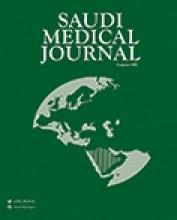Abstract
OBJECTIVE: To evaluate the frequency of 5 mutations and their relationship with the Tel Hashomer criteria in 85 FMF patients.
METHODS: We looked for mutations in the Mediterranean fever (MEFV) gene in 84 consecutive patients who admitted to the Department of Medical Genetics of Afyon Kocatepe University, with a variable (from high to low) clinical suspicion of FMF. By using polymerase chain reaction and Hybridization-ELISA methods, 5 mutations (M694V, M694I, V726A, M680I and E148Q) have been studied between December 2002 and January 2005.
RESULTS: We detected homozygote mutations in 12 patients (25.3%) and heterozygote mutations in 23 patients (48.9%) out of 47 patients with high clinical suspicion of FMF using Tel Hashomer criteria. In 12 patients (25.3%), no mutation was detected despite the clinical diagnosis of FMF was likely according to the Tel Hashomer clinical criteria. On the other hand, we detected homozygote mutations in 2 patients (5.4%) and heterozygote mutations in 17 patients (45.9%) out of 37 patients with low clinical suspicion of FMF using Tel Hashomer criteria. In 18 out of 37 patients (48.6%) in this group no mutation was detected.
CONCLUSION: In patients with high or low clinical suspicion of diagnosis of FMF according to Tel Hashomer criteria, the frequency of homozygote patients was significantly higher than the frequency of patients with no mutation, but it was not higher than the frequency of heterozygote patients.
- Copyright: © Saudi Medical Journal
This is an open-access article distributed under the terms of the Creative Commons Attribution-Noncommercial License (CC BY-NC), which permits unrestricted use, distribution, and reproduction in any medium, provided the original work is properly cited.






